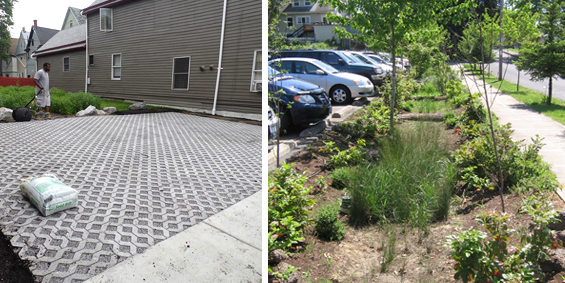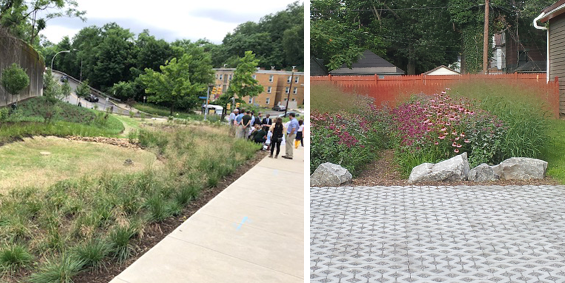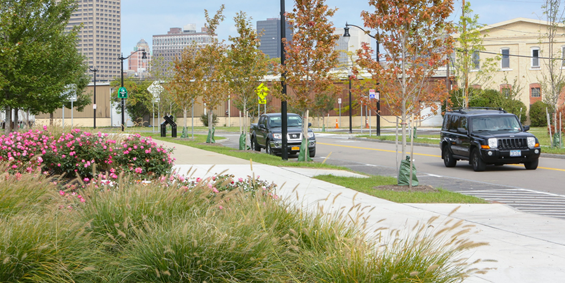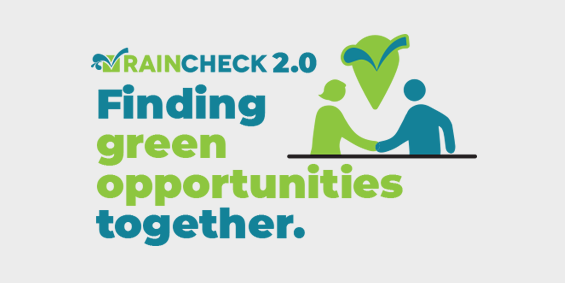Take a look around Buffalo and its neighborhoods.
You’ll find opportunities for green infrastructure in all kinds of everyday places – from rooftops to lawns to driveways and parking lots.
 On parking lots and driveways…
On parking lots and driveways…
Green infrastructure can make parking lots and driveways safe, attractive, and environmentally friendly.
These everyday spaces can be unwelcoming and unsafe for pedestrians, with large stretches of asphalt that produce heavy loads of stormwater runoff. Green infrastructure tools such as de-paving, planting street trees or rain gardens, and installing porous pavement can make parking areas more attractive and limit runoff.
 On buildings and roofs…
On buildings and roofs…
Green infrastructure can catch the water that falls on buildings of all types and sizes—from homes to hospitals.
Green roofs work on most rooftops. They use plants and soils to absorb stormwater, provide aesthetic appeal, and wildlife habitat. Another great, but more low-cost option, is to disconnect downspouts and redirect roof runoff to rain gardens, or to rain barrels that store water for everyday outdoor uses. Cisterns are a better option to harvest runoff from larger buildings, like schools and industrial buildings.
 On landscapes and lawns…
On landscapes and lawns…
Landscaping not only beautifies properties—it can also prevent stormwater runoff.
The city is filled with landscapes—from backyards to college campuses—with many green infrastructure opportunities. Rain gardens spruce up landscapes with water-loving vegetation and soils that capture runoff from driveways and downspouts. Planting trees, topping off lawns with “spongy” topsoil and compost, and installing drainage ditches, are other ways to tackle the stormwater challenge with landscaping.
 On new development projects…
On new development projects…
Buffalo’s new development ordinance, the Green Code, requires stormwater to be managed on any new development site, both during and after construction.
Buffalo’s new development ordinance, the Green Code, requires additional steps for stormwater management on any development site, both during and after construction. For one, any project over ¼ acre must complete a Stormwater Pollution Prevention Plan (SWPP). Smaller developments must also manage runoff responsibly, but are not required to prepare a SWPP.
 On streets and public spaces…
On streets and public spaces…
Green streets use a range of green infrastructure tools to beautify streetscapes and capture roadway runoff.
Tools like street trees, rain gardens, and porous pavement can be used in streetscape projects that involve de-paving. Strategies to increase road safety, like curb bump outs, can also be tailored with green infrastructure. Past green street projects, like Niagara Street and Ohio Street, have coincided with corridor revitalization efforts and increased private investment.
Returning urban landscapes back to a natural state is a powerful way to reduce runoff and its negative impacts.
Restoring streambanks and wetlands can prevent erosion and filter out pollutants from stormwater before reaching waterways. As shown by the restoration of Scajaquada Creek in Forest Lawn Cemetery, the ecological renewal of urban landscapes can also beautify and rejuvenate public spaces.
 Buffalo Sewer is working to identify green opportunities like these in six sewer basins in Buffalo.
Buffalo Sewer is working to identify green opportunities like these in six sewer basins in Buffalo.
Learn more about these partnerships for green opportunities, or contact us to learn how you can get involved.
